My art, music and events scene in NY/NJ
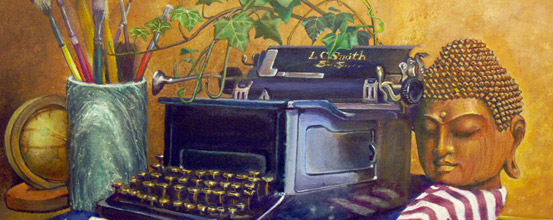
Skinny Puppy new CD “hanDover”

Skinny Puppy/ hanDover/SPV
By Doktor John
This is the 11th complete album by the preeminent electro-industrial group, Skinny Puppy, and is comes across as an unfortunate mellowing-down of the style of this usually boisterous, eccentric band. SP has a tradition of naming their songs with puns and neologisms. Thus we find tracks with names such as like Ovirt and Cullorblind, but I wouldnt suggest you try to find the hidden meanings.
Overall the album is a languid collection of plodding, mournful tracks with reduced rhythm complexity, slowed cadences and toned-down lyrics when compared with the established SP oeuvre. There is conspicuous absence of the delightful and puzzling sound-samples from movies and TV that used to add an element of uniqueness and artistry to SP’s prior albums.
Most of the songs tend to trip along never approaching a climax. Tracks three and four would actually make great backgrounds for falling asleep. Occasionally the rhythm breaks into a light gallop or even a rapid-fire pace. Beats in the track“Point” take the form of recurring electronica derived from video games or perhaps Star Wars weaponry, the effect of which is sadly cheesy.
Dont get me wrong. Theres much in hanDover that has SP’s signature sound. Vyrisus, by far the best track on the album, revives a familiar SP musical device, starting with an eerie, high-pitched note that hangs, drone-like, suspended over a complex and hypnotic rhythm, then is laced with Ogre’s vocals which alternate between a growl and a harsh whisper. But the next track, “Village” morphs into a clone of something by My Life With the Thrill Kill Cult with its driving drum-machine beat. HanDover concludes with “NoiseX” over seven tedious minutes of chaotic sounds having neither a rhythm nor a melody. Many of SP’s better albums traditionally include just such a wastebasket track with leftover noise.
The formula for the album seems to have been to put Ogre’s (Ohgr’s) solo work into a blender with the recent album Mythmaker. This album unfortunately has no breakout special hit single, no powerful or explosive track. There is no delicious melody worked into an industrial soundscape as can to be heard in bygone masterpieces such as “Warlock,” “Addiction” or “Killing Game.” But it is good, serviceable if somewhat mediocre industrial music still bearing the SP flavor, and it is, at the very least, acceptable to the fan base. I have no idea, however, why they would go to the trouble of producing hanDover.
In a word: Uninspired
Rating: B-
Comments (0)
Endless Night Steampunk Soiree [Halloween 2011]

FangMaster Fr. Sebastiaan, known to NYC Goth-scene old-timers who remember Long Black Veil, The Limelight and the Bank is an international impresario, holding events at such Goth capitals of the world as New York City, Paris, France, and soon —perhaps— Venice, Italy. The biggest of these is the Endless Night Vampire Ball held annually in New Orleans, Louisiana—The Big Easy.
This year, the theme was the increasingly popular fashion called “Steampunk” , based on the elaborate and decorative styles that prevailed during the turning point from ancient, historical ways to the nascent industrial/mechanical world of brass gears, top hats, airships, Jules Verne, Mary Shelly and Bram Stoker, nostalgically known as the Age of Steam.





Now do you get the connection?
Well Marzena and I have been wanting to attend the event for a long time, and this year we flew down on Friday to participate in the Endless Night Ball the next day, Saturday, and we were back in the air and home to New Jersey early (very early) Sunday morning.
Here’s a sample of what we saw.
First off, there’s a meet-and-greet (and, optionally, get your fangs made) outdoor event in the back court of The House of Blues on Decatur St, in the French Quarter.
There we were greeted by the merchandise stand selling various items which included Sebastiaan’s latest book, t-shirts with the Endless Night 2011 logo and promoting next year’s events.
Here’s the Fang Master himself fitting a (soon-to-be vampire) customer with new, custom-made and custom-fitted individualized fangs.
As with all such events, there were a panel of hand-picked DJs who spun a mix of classic rock, 80s, alternative, Goth, techno and industrial. We probably could have used less of the nameless techno and classic rock—and more of the Gothic-industrial, but that’s just my taste.

Shown here, the most beautiful and fashionably steam-punked lady in attendance stood out from the crowd.
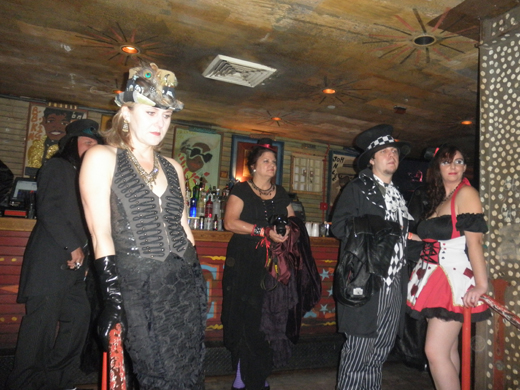
More of the crowd
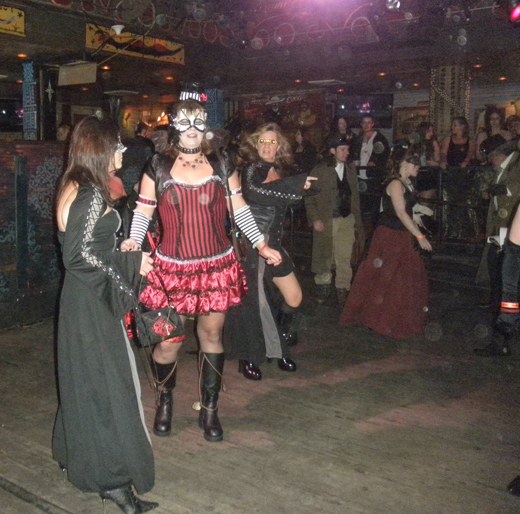
There were dancers—and there were DANCERS

Here was a great-looking couple 
More of the crowd

Some stepped outside the theme with their unique costumes

and some looks were scarier than others!

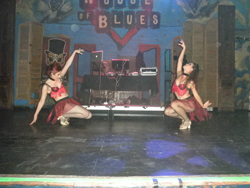
The Grandfather of Goth watching the stage show




Doktor John’s unmistakable choice for best dancer at the event.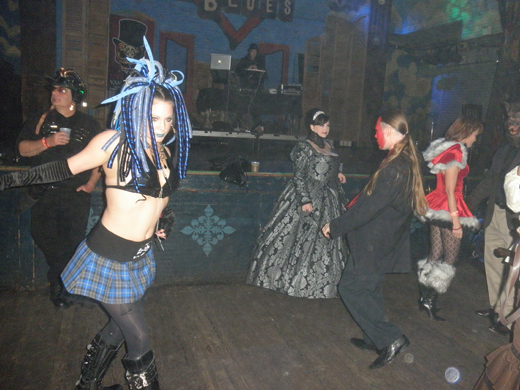
Mark Sinnis – The Undertaker In My Rearview Mirror
The following review was published in the paper edition as well as the online edition of The Aquarian

Mark Sinnis – The Undertaker In My Rearview Mirror
Frontman for Cemetery & Western band Ninth House, Mark Sinnis has released a new album that contains some updated, acoustic and mellow versions of previously recorded Ninth House favorites, countrified even further with honkey tonk piano and acoustic and slide guitars. Sinnis continues expounding obsession with the many ways that the concept of death informs and shapes our viewpoints and our lives.
The title track is new, melodious narrative, partly spoken, partly sung in old-school country style, relates the morbid ruminations of someone who spends a lot of time behind the wheel and features a slide guitar that creates an eerie feeling to accompany his thoughts. Included are covers like “Ghost Riders in the Sky” and re-interpretations of other artists’ works as well as of his own previously recorded songs. A fabulous example is “Fifty Odd Hours,” which is a re-write of the great antique “Sixteen Tons,” a 50s classic by Tennessee Ernie Ford. Both “Death Song” —borrowed from the repertoire of Sinnis’ first band, the Apostates—- and the newly composed sequel, “Departed” are performed as duets featuring the exquisitely sweet voice of frequent collaborator Randi Russo who has the effect of emotionally charging Sinnis’s rich, deep vocals to previously unattained heights.
Sinnis never fails to bring up the traditional theme of the ill consequences as well as the consolations derived from booze, so the thirteenth track closes the album with “I’ll Have Another Drink of Whiskey,” a bar-room style sing-along.
Mark Sinnis has once again released an polished and highly listenable collection of new, old and re-interpreted folk rock featuring his polished dark baritone, fine arrangements, delicious melodies and thoughtful lyrics reflecting his profound love of American roots music.
Peter Murphy – Ninth
The following is an album review that appears in the current issue of The Aquarian

Peter Murphy/ Ninth
On Nettwerk Records
By Doktor John
When the seminal Gothic rock band Bauhaus broke up in 1983, the founding members went off in different directions. Frontman Peter Murphy went solo and produced three albums, Deep, Holy Smoke and Cascade that, while more melodious, represented a continuation of the dark tradition on which the original band was founded. Numerous singles from those albums went on to become mainstays of gothic-industrial and underground clubs. But it has been sixteen years since Cascade, he has relocated to Turkey, and all he has produced musically have been the forgettable Unshattered; Dust, an incongruous probe into Near Eastern mysticism; some greatest hits collections; and a reunion album with Bauhaus. Now with Ninth, however, he has at last resurrected the richly vocal, emotionally moving style that renders his supporters delirious with enthusiasm.
The opening track, “I Spit Roses,†has the enigmatic poetry and complex, layered rhythms that characterized all of his best works. “Seesaw Sway†is one of the best cuts on the album and restores Murphy to the top tier of dark rock, utilizing his broad vocal range. All Murphy’s albums have at least one tender-hearted ballad, and on Ninth that would be “Crème de la Crème†which begins with velvety vocals and a simplified one-hand piano accompaniment but surges to a passionate, symphonic crescendo.
“Velocity Bird†is in true rock’n’roll style and Murphy’s lyrics pose a poetic riddle of the kind that only he concocts. “Uneven & Brittle†features power chord guitar riffs and menacing vocals, but contains a soft-spoken narrative in its middle. “Peace to Each†sounds like vintage Bauhaus with discordant singing over a driving rhythm.
One of the absolute gems of the album is “The Prince & Old Lady Shade†that will find its place among the best and most beloved songs he has ever sung for its mesmerizing beat, layered arrangement and virtuoso vocals.
“Memory Go†and “Never Fall Out†are fine, listenable and danceable without being standouts on their own merits. “Secret Silk Society†is the pitch-black, atonal and creepy finale in the early Bauhaus spirit that Peter Murphy carries on.
Ninth is vintage Peter Murphy and will more than satisfy his ardent fans who have been waiting for an album of this quality.
Rating: A
In a word: Consummate
Peter Gabriel in Camden/Philadelphia

Peter Gabriel / Susquehanna Bank Center / Jun. 25, 2011
by Doktor John
Camden, NJ
The renowned father of World Beat, singer-songwriter Peter Gabriel appeared at this 25,000-seat venue which serves the greater Philadelphia area on his New Blood Tour, accompanied by a 40 piece orchestra. Apparently Gabriel, who in decades past founded the prog-rock Genesis, has abandoned rock music, at least for the moment, employing arranger John Metcalf to transform his songs into the modern classical style resembling the orchestral works of Leonard Bernstein and others 20th Century composers. Always a social activist for progressive causes, Gabriel has intensified his discussion of political issues, using the stage as a pulpit from which to preach his vision of third-world justice and liberation philosophy.
Norwegian songstress, and vocally delicate, blond beauty Ane Brun opened with two of her own folk-rock songs, accompanying herself on a classical guitar.
A dazzling, brilliant, ever changing and spectacularly-lit electronic screen served as a curtain which slowly lifted away during Gabriel’s heavy, melancholy version of Bowie’s “Heroes,” with video images of third world strife shown on a pair of twenty-foot high screens that straddled the stage.
Aside from his morose rendition of Arcade Fire’s “My Body Is a Cage,” and “Diggin’ In the Dirt,” I wasn’t familiar with many other songs in the first half of the show. Perhaps I didn’t recognize them in the symphonic style in which they were played, featuring relentless, often-discordant, full string section accompaniment and with no semblance of a rock beat. Guitars were absent, and the only drums seemed to be the tympani. Between songs, Gabriel, who remained heavy-hearted for most of the show, praised the triumph of legalization of same sex marriage in New York.
A coincidental fireworks display over the Delaware drew the attention of many during the half-hour break. Gabriel lamented that he had hoped to sing his mantra-like encomium to South African martyr “Biko” accompanied by the sounds of the nearby explosions, but that didn’t work out. Most spectators returned to their seats during “San Jacinto” which was the first number after the intermission. The ultra-close-up face of a wild animal, perhaps a wolf, blended with his own countenance on the video display, and we knew that it had something to do with animal rights or ecology.
The first really upbeat song of the night was “Secret World,” and it came as a welcome relief from all the somber topics and sounds. Gabriel soon continued with his liturgy of liberal causes invoking the names of poets and psychoanalysts, often in the context of encounters with noble, indigenous cultures. He showed a touching, grainy black and white video of himself with his now-99 year-old dad during a heart-breaking rendition of “Father Son.”
Ever topical, he introduced a ponderous version of “Signal to Noise” with a jocular commentary about the pervasiveness of cell phones in this day and age. But then the gloomy “Mercy Street”, with its mysterious beach-sand and aquatic video continued to bring people down to a contemplative state. Joy returned to the audience during the inappropriately exuberant “Red Rain,” which was played while the video showed scary, primitively-drawn cartoons of red droplets coming from clouds, from eyes and from the sky. He ended the second set skipping his thick frame across the stage to the “boom boom boom” of “Solsbury Hill.”
An encore set included the relatively cheerful “In Your Eyes” followed by a doleful “Don’t Give Up,” which he explained was dedicated to the suffering of the “Great Depression,” which he added was to be blamed on “the magnificent work of the banks.” Ane Brun, who served as one of the backup vocalists during the whole concert, took on the role sung by Kate Bush in the original.
Drawing to a close, he struck an optimistic chord by bringing up what he perceives to be the realistic possibility of endless clean energy through fusion, something he was promised was due to go online with a year.
His final number, “The Nest that Sailed the Skies,” was purely instrumental, showing a video of a child curled in fetal position in a straw bird’s nest, spinning gently as an obvious metaphor for the Earth that Gabriel so badly wants us to revere as precious.
Social Distortion at the Stone Pony



Saturday May 14 saw the Social Distortion tour land at NJ’s historic Stone Pony Summerstage in support of their latest album, Hard Times and Nursery Rhymes. (Scroll down to see the review of the album or click on the link at right: “Recorded Music,” under “Reviews”) There were two opening bands, the first less noteworthy, and the second, a Celtic-style country band with a virtuoso fiddler, was more fun to listen to, although we never learned their name. 
A slight drizzle passed through and night fell. Around 8:30 PM Social Distortion blew onto the stage with Mike Ness sporting a fedora complete with a feather in the hatband and wearing a long, black raincoat. The raincoat came off revealing retro-style suspenders over a white shirt and dark pants. They were immediately into a charged-up version of the instrumental “Road Zombie,” opening track off Hard Times and Nursery Rhymes, then went straight into “So Far Away,” off the 1990 eponymous album, Social Distortion.


Ness’s recurring theme is self-recrimination, so well propounded in the next three pieces, “King of Fools,” “Bad Luck” and “Mommy’s Little Monster.”
He then announced and the band performed a 1982 obscurity, whose title we never caught before launching into the favorite radio hit “Machine Gun Blues” from the new album. This was followed by what may be the best known and loved of all their oeuvre, “Ball and Chain” which charged the crowd both musically and emotionally.
Mike Ness took time to warm to his audience with some affectionate patter, then launched into “Don’t Drag Me Down” from White Light White Heat and the slow-dance ballad “Bakersfield.” Something at that point made Ness observe how crazy-looking certain members of the crowd appeared to be as a segue into “Gimme the Sweet and Lowdown.”

Once again he picked up the negative self-image theme with “Down Here With the Rest of Us,” but sang a song of ambivalent redemption in “Reach for the Sky” off the 2004 Sex, Love and Rock’n’Roll.
Then it was back to songs of remorse with “Prison Bound.”

He stopped to talk and to cajole the audience with the back-handed compliment that their lives were every bit a messed up as his and that they were, as much as Ness himself, the subjects of his narratives, thus introducing the much beloved “Story of My Life.”With that, they thanked us and bid us good night signifying that the main performance.

Within a few minutes they stormed back out, Ness spoke a little about NJ and the East Coast sound, making reference to Bruce Springsteen, but there was no Springsteen cover. Instead, after summoning a pair of female back-up vocalists they proceeded into “California Hustle and Flow” and the execrable “Can’t Take It With You.” Neither Mike Ness solo nor Social D as a group are shy about paying tribute, which is exactly how they ended, namely with Merle Kilgore’s and June Carter’s anthemic “Ring of Fire,” made into an American musical classic by her husband, the great Johnny Cash. This left the crowd totally satisfied.


